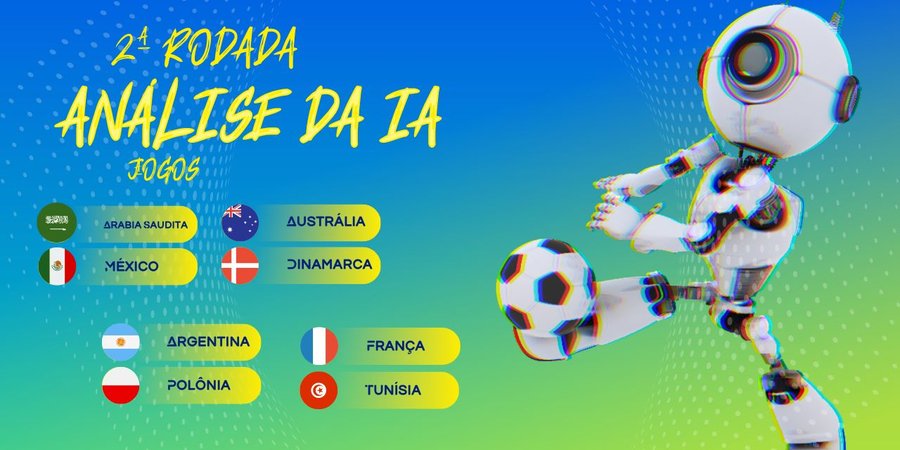
A Promessa e o Perigo da Nova Revolução Digital
A nova corrida tecnológica global levanta uma pergunta urgente: estamos prontos para confiar na inteligência que criamos?

Arabia Saudita: 1
México: 2
Arabia Saudita teve 20% de performance relativa a uma equipe de alta performance e México teve 42%.
Intensidade relativa no jogo:
Arabia Saudita: 32%
México: 68%
Finalizações:
Excelente número de finalizações na partida, 34.
Arabia Saudita: teve bom número de finalizações comparando a uma equipe de alta performance. A taxa de direção ao gol foi de 20%, que é uma taxa ruim
México: teve excelente número de finalizações comparando com uma equipe de alta performance. A taxa de direção ao gol foi de 46%, que é uma boa taxa.
Quem mais finalizou certo: México-Luis Chavez, meia, finalizando 4 vezes.
Desarmes:
Arabia Saudita: neutralizou 10% das jogadas do adversário.
México: neutralizou 15% das jogadas do adversário, uma taxa acima da média.
Arabia Saudita-Abdulelah Al Amri, zagueiro e México-Edson Alvarez, meia foram os que mais desarmaram.
Passes:
Arabia Saudita: precisa evoluir. Os erros nos passes podem significar uma derrota. Usou 20% de passes longos como recursos.
México: precisa evoluir. Os erros nos passes podem significar uma derrota. Usou 17% de passes longos como recursos.
México-Héctor Moreno, zagueiro foi quem mais acertou passes.
O que manter:
Arabia Saudita: nenhum destaque de alta performance
México: quantidade de finalizações e taxa de desarmes
O que melhorar:
Arabia Saudita: intensidade
México: taxa de direção de gol
Os incansáveis do jogo foram:
México-Luis Chavez, meia
México-Edson Alvarez, meia
As melhores performances:
Edson Alvarez, meia do México
Cesar Montes, zagueiro do México
Hector Moreno, zagueiro do México
Pior performance:
Feras Al Brikan, meia do Arabia Saudita
Austrália: 1
Dinamarca: 0
Austrália teve 22% de performance relativa a uma equipe de alta performance e Dinamarca teve 70%.
Intensidade relativa no jogo:
Austrália: 24%
Dinamarca: 76%
Finalizações:
Regular número de finalizações no jogo, 21.
Austrália: teve regular número de finalizações. A taxa de direção ao gol foi de 50%, que é uma boa taxa.
Dinamarca: teve bom número de finalizações comparando a uma equipe de alta performance. A taxa de direção ao gol foi de 23%, que é uma taxa ruim.
Quem mais finalizou certo: Austrália-Mitchell Duke, atacante, finalizando 2 vezes.
Desarmes:
Austrália: neutralizou 7% das jogadas do adversário, que é abaixo da média.
Dinamarca: neutralizou 17% das jogadas do adversário, acima da média.
Dinamarca-Joachim Andersen, zagueiro e Austrália-Milos Degenek, zagueiro foram os que mais desarmaram.
Passes:
Austrália: precisa evoluir. Os erros nos passes podem significar uma derrota. Usou 11% de passes longos como recursos.
Dinamarca: teve taxa boa. Usou 10% de passes longos como recursos.
Dinamarca-Joachim Andersen, zagueiro foi quem mais acertou passes.
O que manter:
Austrália: nenhum destaque de alta performance
Dinamarca: taxa de desarmes
O que melhorar:
Austrália: intensidade
Dinamarca: taxa de finalizações na direção do gol
Os incansáveis do jogo foram:
Dinamarca-Joachim Andersen, zagueiro
Dinamarca-Andreas Christensen, zagueiro
Dinamarca-Pierre Hojbjerg, volante
As melhores performances:
Joachim Andersen, zagueiro do Dinamarca
Andreas Christensen, zagueiro do Dinamarca
Pierre Hojbjerg, volante do Dinamarca
Pior performance:
Andreas Cornelius, atacante do Dinamarca
Argentina: 2
Polônia: 0
Argentina teve 96% de performance relativa a uma equipe de alta performance e Polônia teve 30%.
Intensidade relativa no jogo:
Argentina: 76%
Polônia: 24%
Finalizações:
Bom número de finalizações na partida, 28.
Argentina: teve excelente número de finalizações comparando com uma equipe de alta performance. A taxa de direção ao gol foi de 54%, que é uma boa taxa.
Polônia: teve um número de finalizações ruim. A taxa de direção ao gol foi de 0%, que é uma taxa ruim.
Quem mais finalizou certo: Argentina-Lionel Messi, atacante, finalizando 4 vezes.
Desarmes:
Argentina: neutralizou 15% das jogadas do adversário, acima da média.
Polônia: neutralizou 5% das jogadas do adversário, abaixo da média.
Polônia-Kamil Glik, zagueiro e Polônia-Matty Cash, lateral foram os que mais desarmaram.
Passes:
Argentina: teve taxa de alta performance. Usou 5% de passes longos como recursos.
Polônia: precisa evoluir. Os erros nos passes podem significar uma derrota. Usou 14% de passes longos como recursos.
Argentina-Rodrigo de Paul, volante foi quem mais acertou passes.
O que manter:
Argentina: quase tudo
Polônia: não houve destaque de alta performance
O que melhorar:
Argentina: nenhum destaque negativo
Polônia: intensidade, inicialmente.
Os incansáveis do jogo foram:
Argentina-Rodrigo de Paul, volante
Argentina-Nicolás Otamendi, zagueiro
Argentina-Lionel Messi, atacante
As melhores performances:
Rodrigo de Paul, volante do Argentina
Nicolás Otamendi, zagueiro do Argentina
Enzo Fernández, meia do Argentina
Pior performance:
Robert Lewandowski, atacante do Polônia
França: 0
Tunísia: 1
França teve 64% de performance relativa a uma equipe de alta performance e Tunísia teve 29%.
Intensidade relativa no jogo:
França: 69%
Tunísia: 31%
Finalizações:
Regular número de finalizações no jogo, 16.
França: teve bom número de finalizações comparando a uma equipe de alta performance. A taxa de direção ao gol foi de 40%, que é regular
Tunísia: teve um número de finalizações ruim. A taxa de direção ao gol foi de 50%, que é uma boa taxa.
Quem mais finalizou certo: França-Kylian Mbappe, atacante, finalizando 2 vezes.
Desarmes:
França: neutralizou 24% das jogadas do adversário. Taxa acima da média.
Tunísia: neutralizou 11% das jogadas do adversário.
França-Eduardo Camavinga, meia e França-Axel Disasi, zagueiro foram os que mais desarmaram.
Passes:
França: teve taxa boa. Usou 7% de passes longos como recursos.
Tunísia: precisa evoluir. Os erros nos passes podem significar uma derrota. Usou 12% de passes longos como recursos.
França-Aurélien Tchouaméni, volante foi quem mais acertou passes.
O que manter:
França: taxa de desarmes.
Tunísia: nenhum destaque de alta performance.
O que melhorar:
França: quantidade de chutes a gol e taxa de direção
Tunísia: intensidade
Os incansáveis do jogo foram:
França-Eduardo Camavinga, meia
França-Aurélien Tchouaméni, volante
França-Axel Disasi, zagueiro
As melhores performances:
Eduardo Camavinga, meia do França
Ibrahima Konaté, zagueiro do França
Aurélien Tchouaméni, volante do França
Pior performance:
Issam Jebali, atacante do Tunísia
A Inteligência Artificial não entende de futebol, mas revela padrões e detalhes importantes para profissionais, especialistas e executivos que desejam identificar pontos chave de melhora consistente nos seus negócios.
Uma das grandes vantagens da IA é a capacidade de análise em profundidade em tempo real, mantendo o negócio em questão com alto nível de dinamismo.
(*) FIF-AI: Fator de Intensidade de Futebol, desenvolvido com aplicação de IA - Inteligência Artificial aplicada a dados de futebol gerados a partir de jogos de alta performance e atualizado com técnicas de aprendizado contínuo.

A nova corrida tecnológica global levanta uma pergunta urgente: estamos prontos para confiar na inteligência que criamos?

Por que dominar a IA será a nova alfabetização do século XXI

Conselhos de Administração devem evoluir da supervisão reativa para a antecipação estratégica, frente à crescente complexidade e volatilidade dos ambientes de negócios.

De 14 a 25 de julho, reserve suas manhãs das 08h00 às 09h30 para participar da tradicional Maratona I2AI! Uma jornada intensa com debates e palestras sobre temas essenciais: Ética,